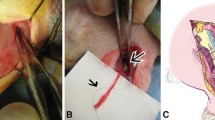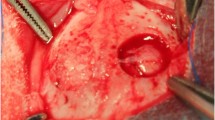Abstract
Background
Allograft integration in segmental osseous defects is unpredictable. Imaging techniques have not been applied to investigate angiogenesis and bone formation during allograft healing in a large-animal model.
Questions/purposes
We used dynamic contrast-enhanced (DCE)-MRI and cone beam (CB)-CT to quantify vascularity and bone volume in a canine femoral allograft model and determined their relationship with biomechanical testing and histomorphometry.
Methods
Femoral ostectomy was performed in three dogs and reconstructed with a 5-cm allograft and compression plate. At 0.5, 3, and 6 months, we performed DCE-MRI to quantify vascular permeability (Ktrans) and perfused fraction and CB-CT to quantify bone volume. We also performed posteuthanasia torsional testing and dynamic histomorphometry of the grafted and nonoperated femurs.
Results
DCE-MRI confirmed the avascular nature of allograft healing (perfused fraction, 2.08%–3.25%). CB-CT demonstrated new bone formation at 3 months (26.2, 3.7, and 2.2 cm3) at the graft-host junctions, which remodeled down at 6 months (14.0, 2.2, and 2.0 cm3). The increased bone volume in one subject was confirmed with elevated Ktrans (0.22) at 3 months. CB-CT-identified remodeled bone at 6 months was corroborated by histomorphometry. Allografted femurs recovered only 40% of their strength at 6 months.
Conclusions
CB-CT and DCE-MRI can discriminate differences in angiogenesis and bone formation in the canine allograft model, which has potential to detect a small (32%) drug or device effect on biomechanical healing with only five animals per group.
Clinical Relevance
These radiographic tools may have the potential to assess adjuvant effects on vascular invasion and new bone formation after segmental allograft transplantation.




Similar content being viewed by others
References
Ashton EA, McShane T, Evelhoch J. Inter-operator variability in perfusion assessment of tumors in MRI using automated AIF detection. Lect Notes Comput Sci. 2005;3749:451–458.
Berrey BH Jr, Lord CF, Gebhardt MC, Mankin HJ. Fractures of allografts: frequency, treatment, and end-results. J Bone Joint Surg Am. 1990;72:825–833.
Bos GD, Goldberg VM, Zika JM, Heiple KG, Powell AE. Immune responses of rats to frozen bone allografts. J Bone Joint Surg Am. 1983;65:239–246.
Brigman BE, Hornicek FJ, Gebhardt MC, Mankin HJ. Allografts about the knee in young patients with high-grade sarcoma. Clin Orthop Relat Res. 2004;421:232–239.
Burchardt H. The biology of bone graft repair. Clin Orthop Relat Res. 1983;174:28–42.
Burkus JK, Sandhu HS, Gornet MF, Longley MC. Use of rhBMP-2 in combination with structural cortical allografts: clinical and radiographic outcomes in anterior lumbar spinal surgery. J Bone Joint Surg Am. 2005;87:1205–1212.
Ehrhart N, Kraft S, Conover D, Rosier RN, Schwarz EM. Quantification of massive allograft healing with dynamic contrast enhanced-MRI and cone beam-CT: a pilot study. Clin Orthop Relat Res. 2008;466:1897–1904.
Enneking WF, Campanacci DA. Retrieved human allografts: a clinicopathological study. J Bone Joint Surg Am. 2001;83:971–986.
Enneking WF, Mindell ER. Observations on massive retrieved human allografts. J Bone Joint Surg Am. 1991;73:1123–1142.
Ernstberger T, Heidrich G, Bruening T, Krefft S, Buchhorn G, Klinger HM. The interobserver-validated relevance of intervertebral spacer materials in MRI artifacting. Eur Spine J. 2007;16:179–185.
Ito H, Koefoed M, Tiyapatanaputi P, Gromov K, Goater JJ, Carmouche J, Zhang X, Rubery PT, Rabinowitz J, Samulski RJ, Nakamura T, Soballe K, O’Keefe R J, Boyce BF, Schwarz EM. Remodeling of cortical bone allografts mediated by adherent rAAV-RANKL and VEGF gene therapy. Nat Med. 2005;11:291–297.
Koefoed M, Ito H, Gromov K, Reynolds DG, Awad HA, Rubery PT, Ulrich-Vinther M, Soballe K, Guldberg RE, Lin AS, O’Keefe R J, Zhang X, Schwarz EM. Biological effects of rAAV-caAlk2 coating on structural allograft healing. Mol Ther. 2005;12:212–218.
Looney RJ, Boyd A, Totterman S, Seo GS, Tamez-Pena J, Campbell D, Novotny L, Olcott C, Martell J, Hayes FA, O’Keefe RJ, Schwarz EM. Volumetric computerized tomography as a measurement of periprosthetic acetabular osteolysis and its correlation with wear. Arthritis Res. 2002;4:59–63.
Lord CF, Gebhardt MC, Tomford WW, Mankin HJ. Infection in bone allografts: incidence, nature, and treatment. J Bone Joint Surg Am. 1988;70:369–376.
Pluhar GE, Manley PA, Heiner JP, Vanderby R Jr, Seeherman HJ, Markel MD. The effect of recombinant human bone morphogenetic protein-2 on femoral reconstruction with an intercalary allograft in a dog model. J Orthop Res. 2001;19:308–317.
Ramos-Cabrer P, van Duynhoven JP, Van der Toorn A, Nicolay K. MRI of hip prostheses using single-point methods: in vitro studies towards the artifact-free imaging of individuals with metal implants. Magn Reson Imaging. 2004;22:1097–1103.
Reynolds DG, Hock C, Shaikh S, Jacobson J, Zhang X, Rubery PT, Beck CA, O’Keefe R J, Lerner AL, Schwarz EM, Awad HA. Micro-computed tomography prediction of biomechanical strength in murine structural bone grafts. J Biomech. 2007;40:3178–3186.
Reynolds DG, Shaikh S, Papuga MO, Lerner AL, O’Keefe RJ, Schwarz EM, Awad HA. μCT-based measurement of cortical bone graft-to-host union. J Bone Miner Res. 2009;24:899–907.
Reynolds DG, Takahata M, Lerner AL, O’Keefe RJ, Schwarz EM, Awad HA. Teriparatide therapy enhances devitalized femoral allograft osseointegration and biomechanics in a murine model. Bone. 2010;48:562–570.
Santoni BG, Ehrhart N, Turner AS, Wheeler DL. Effects of low intensity pulsed ultrasound with and without increased cortical porosity on structural bone allograft incorporation. J Orthop Surg Res. 2008;3:20.
Santoni BG, Simon Turner A, Wheeler DL, Nicholas RW, Anchordoquy TJ, Ehrhart N. Gene therapy to enhance allograft incorporation after host tissue irradiation. Clin Orthop Relat Res. 2008;466:1921–1929.
Stevenson S, Emery SE, Goldberg VM. Factors affecting bone graft incorporation. Clin Orthop Relat Res. 1996;324:66–74.
Stevenson S, Li XQ, Davy DT, Klein L, Goldberg VM. Critical biological determinants of incorporation of non-vascularized cortical bone grafts: quantification of a complex process and structure. J Bone Joint Surg Am. 1997;79:1–16.
Takahata M, Awad HA, O’Keefe RJ, Bukata SV, Schwarz EM. Endogenous tissue engineering: PTH therapy for skeletal repair. Cell Tissue Res. 2012;347:545–552.
Tiyapatanaputi P, Rubery PT, Carmouche J, Schwarz EM, O’Keefe R J, Zhang X. A novel murine segmental femoral graft model. J Orthop Res. 2004;22:1254–1260.
Tsuchida H, Hashimoto J, Crawford E, Manske P, Lou J. Engineered allogeneic mesenchymal stem cells repair femoral segmental defect in rats. J Orthop Res. 2003;21:44–53.
Weinstein RS, Parfitt AM, Marcus R, Greenwald M, Crans G, Muchmore DB. Effects of raloxifene, hormone replacement therapy, and placebo on bone turnover in postmenopausal women. Osteoporos Int. 2003;14:814–822.
Weinstein RS, Roberson PK, Manolagas SC. Giant osteoclast formation and long-term oral bisphosphonate therapy. N Engl J Med. 2009;360:53–62.
Wheeler DL, Enneking WF. Allograft bone decreases in strength in vivo over time. Clin Orthop Relat Res. 2005;435:36–42.
Xie C, Reynolds D, Awad H, Rubery PT, Pelled G, Gazit D, Guldberg RE, Schwarz EM, O’Keefe RJ, Zhang X. Structural bone allograft combined with genetically engineered mesenchymal stem cells as a novel platform for bone tissue engineering. Tissue Eng. 2007;13:435–445.
Yazici C, Takahata M, Reynolds DG, Xie C, Samulski RJ, Samulski J, Beecham EJ, Gertzman AA, Spilker M, Zhang X, O’Keefe RJ, Awad HA, Schwarz EM. Self-complementary AAV2.5-BMP2-coated femoral allografts mediated superior bone healing versus live autografts in mice with equivalent biomechanics to unfractured femur. Mol Ther. 2011;19:1416–1425.
Zabka AG, Pluhar GE, Edwards RB 3rd, Manley PA, Hayashi K, Heiner JP, Kalscheur VL, Seeherman HJ, Markel MD. Histomorphometric description of allograft bone remodeling and union in a canine segmental femoral defect model: a comparison of rhBMP-2, cancellous bone graft, and absorbable collagen sponge. J Orthop Res. 2001;19:318–327.
Zhang X, Xie C, Lin AS, Ito H, Awad H, Lieberman JR, Rubery PT, Schwarz EM, O’Keefe R J, Guldberg RE. Periosteal progenitor cell fate in segmental cortical bone graft transplantations: implications for functional tissue engineering. J Bone Miner Res. 2005;20:2124–2137.
Acknowledgments
We thank our collaborative authors from the University of Rochester, Masahiko Takahata, MD, and Chao Xie, MD, for their assistance in the daily observations of the canine subjects and care for the animals during DCE-MRI and CB-CT; David Conover, MS, for his help running the CB-CT scanner; and Hani A. Awad, PhD, for help with the experimental design and data analyses. We also thank Synthes Inc for providing surgical equipment and implants.
Author information
Authors and Affiliations
Corresponding author
Additional information
One or more of the authors (BGS, NE, EMS) have received funding from the Musculoskeletal Transplant Foundation (Edison, NJ, USA). One or more of the authors have received funding from the following grants: NIH PHS AR054041 (EMS), AR056696 (EMS), DE019902 (EMS), AR061307 (EMS), and 1R01EB012048-01A1 (BGS).
All ICMJE Conflict of Interest Forms for authors and Clinical Orthopaedics and Related Research editors and board members are on file with the publication and can be viewed on request.
Each author certifies that his or her institution approved the animal protocol for this investigation and that all investigations were conducted in conformity with ethical principles of research.
All in vivo work and ex vivo cone beam CT and imaging analyses were performed at the University of Rochester, Rochester, NY, USA. The ex vivo biomechanics, histology, and histomorphometry were performed at Colorado State University, Fort Collins, CO, USA.
About this article
Cite this article
Santoni, B.G., Ehrhart, N., Betancourt-Benitez, R. et al. Quantifying Massive Allograft Healing of the Canine Femur In Vivo and Ex Vivo: A Pilot Study. Clin Orthop Relat Res 470, 2478–2487 (2012). https://doi.org/10.1007/s11999-012-2349-9
Published:
Issue Date:
DOI: https://doi.org/10.1007/s11999-012-2349-9




